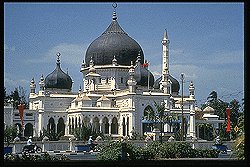| LinkExchange Member | Free Home Pages at GeoCities |
| LinkExchange Member | Free Home Pages at GeoCities |

Kedah sits in the northwest corner of Peninsular
Malaysia. The state is fairly small, covering an area of 9,425 sq
km that consists mostly of expansive padi fields and gently
rolling hills. Off its coast are the legendary Malaysian isles of
Langkawi, and rising to meet the
western shoreline is the mountain of Gunung Jerai (1,200 meters
above sea level). Kedah's population of about one million is
primarily Malay, though there are significant Chinese and Indian
minorities.

Archaeological evidence suggests that Kedah is the site of Peninsular Malaysia's oldest civilization. Before the sea route around the peninsula was firmly established, trade between India and China was conducted across the peninsular isthmus. One of the primary trading centres for this overland trade was a Hindu-Buddhist kingdom that flourished from the fourth to the seventh century in the Bujang Valley, just south of the peak of Gunung Jerai (and thus easily located by early Indian mariners). Like Malacca a thousand years later, the Bujang Valley civilization attracted a cosmopolitan population of merchants and traders, including Indians, Chinese, Achenese (from Sumatra), Burmese, and Arabs. With the arrival of Arab traders, Islam arrived on the Peninsula for the first time, though the most substantial cultural influence came from Pallava India.
As was the case with many of Malaysia's greatest trading civilizations, the Bujang Valley kingdom's prosperity made it an attractive target for outsiders. The region came under the influence of the Sumatran kingdom of Sri Vijaya in the 7th and 8th century, followed by a period during which Kedah was dominated by the Thai states to the north. Kedah's ancient civilisation waned in importance by the 15th century, when Malacca assumed a more dominant role. The establishment of Islam in Kedah is due to Malacca's influence.
When Malacca fell to the Portuguese, the influence of its Sultanate over Kedah weakened. However, other powers soon asserted themselves in Kedah, including both the Portuguese and the rising Achenese, and by the end of the 18th century the Thai threat arose once more. Fearing renewed domination by its northern neighbours, Kedah appealed to the British for assistance. As inducements to a committment, Kedah ceded first Penang (1796) and then the adjoining strip of coastal land (1800) to the British. Nonetheless, Kedah fell to the Thais in 1821. Thailand transferred their sovereignty to the British in 1909. With the exception of the period of occupation by the Japanese during World War II, Kedah remained under British influence until independence.

 Bujang Valley (Lembah Bujang)
Bujang Valley (Lembah Bujang)
The Bujang Valley is a sprawling historical site located in the
foothills of Gunung Jerai. It is the richest archaeological area
in Malaysia. Archaeological research indicates that an ancient
Hindu-Buddhist kingdom ruled here as early as 300 AD. Relics of
the kingdom found at the site and now on display at the
Archaeological Museum include inscribed stone caskets and
tablets, metal tools and ornaments, ceramics, pottery, and Hindu
icons. More than fifty ancient tomb temples, called candi, have
also been unearthed, many of which were built during the Bujang
Valley civilization's heyday. Near the most impressive and
well-preserved of these, in Pengkalan Bayang Merbok, is the
Bujang Valley Archaeological Museum. It is open from 9.30am-5pm
daily.
Gunung Jerai
Balai Nobat (Hall of Drums)
Balai Besar
 Masjid Zahir
Masjid Zahir
Officially opened in 1912, this mosque is an architectural
landmark. With black domes set off against slender minarets, the
Masjid Zahir is one of the most elegant and aesthetically
pleasing mosques in Malaysia. The state's Quran reading
competition is held annually within the premises of the mosque.
State Museum
Pekan Rabu
Pantai Merdeka
Pulau Langkawi

[Main Page] [Myths & Legends] [Culture]
[Festival] [Terms] [Links] [Credits]
[Sign Guestbook] [View Guestbook]